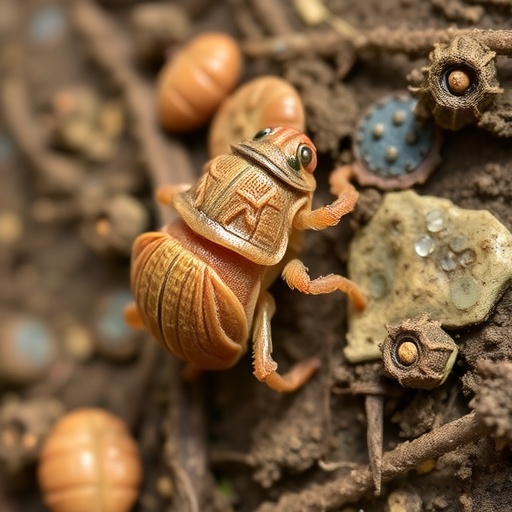In a groundbreaking study published in the renowned Scientific Nature, researchers explored the unique surface properties of cicada exuviae, highlighting their remarkable ability to either adhere to soil or repel water. This fascinating investigation not only unveils the hidden wonders of nature but also holds potential applications in biomimicry and materials science. The cicada, an insect known for its iconic transformation and striking aesthetics, has been a subject of scientific study for decades. Yet, this investigation delves deeper into the physical and chemical characteristics of cicada exuviae, the shed exoskeletons of these remarkable creatures.
The team led by researchers Murayama, Yamazaki, and Ogasawara identified several intriguing properties of cicada exuviae, particularly their dual functionality. The study revealed that depending on environmental conditions, the surface of cicada exuviae can exhibit either adhesive properties, allowing it to cling to soil particles, or hydrophobic characteristics, causing water to bead and roll off. This duality suggests an evolutionary advantage, equipping cicadas to thrive in a variety of habitats and conditions.
A closer examination of the cicada’s exuviae under a microscope revealed a complex surface structure composed of nano- and micro-scale features. These intricacies play a vital role in determining the interaction between the exuviae and their surrounding environment. When in contact with soil, these intricate patterns can enhance adhesion, creating a stronger bond that aids in stabilizing their environments. Conversely, when moisture is prevalent, the unique hydrophobic properties prevent water from adhering, thereby minimizing erosion and potential damage to the exuviae.
The researchers employed state-of-the-art analytical techniques, including scanning electron microscopy (SEM) and atomic force microscopy (AFM), to characterize the surface topography of the cicada exuviae. Through this analysis, they uncovered how these tiny surface features influence the macroscopic behavior of the exuviae. The implications of these findings extend far beyond entomology; they open doors for technological innovation inspired by nature’s designs.
Furthermore, the study’s findings resonate with the burgeoning field of biomimicry, where scientists and engineers draw inspiration from natural systems to solve human challenges. The cicada exuviae’s unique properties could inspire new materials or coatings that exhibit similar soil-adhesive or water-repellent characteristics, potentially revolutionizing how we design tools, construction materials, or even clothing. The concept of utilizing nature as a blueprint for innovative solutions is gaining momentum, and this research serves as a testament to its potential.
Implications of such findings are vast, especially in environmental management and agriculture. Understanding how a natural organism can prevent soil erosion and enhance water retention may lead to the development of improved agricultural practices. Applying the principles observed in cicada exuviae could assist in creating sustainable technologies that better align with ecological principles.
The evolutionary journey of the cicada, known for its life cycle spent underground before its transformative emergence, adds an additional layer of intrigue to this study. The adaptations observed in cicada exuviae may well be reflections of millions of years of evolution, tuned finely to the demands of their environment. Each year, cicadas emerge in cycles, impacting the ecosystems they inhabit, and this research underscores the significance of their physical adaptations.
In light of climate change and its repercussions on our ecosystems, understanding the characteristics of such resilient species takes on new urgency. As cicadas increasingly become symbols of resilience in dynamic habitats, studying their unique features can provide insights into how organisms adapt at both micro and macro levels. Such knowledge is invaluable not only for ecological studies but also for informing conservation efforts aimed at preserving these remarkable insects and the habitats they enrich.
As the boundaries between biology and technology blur, this study paves the way for future research that can further elucidate the mysteries surrounding cicada exuviae. The potential for interdisciplinary collaboration becomes apparent, intertwining biology, materials science, and environmental engineering in exciting new ways. With the rapid advancement of materials research, the cicada’s surface characteristics may find tangible applications in industries ranging from construction to clothing manufacturing.
In conclusion, the discovery by Murayama and colleagues highlights the fascinating interplay between structure and function within natural organisms. The cicada exuviae serves as a compelling example of how nature’s designs can inspire innovation, particularly in material science and environmental management. As researchers continue to unravel the complexities of such natural phenomena, we may find ourselves closer to harnessing these wonders for the benefit of human endeavors.
The research not only highlights the capabilities of cicada exuviae but also calls for a deeper appreciation of the intricacies found in seemingly simple organisms. With continued exploration, who knows what other natural phenomena might become the basis for the next wave of technological advancements? In a world increasingly reliant on sustainable innovation, studying nature’s masterpieces such as the cicada may be the key to paving a more resilient future.
Therefore, the insights gleaned from analyzing cicada exuviae provide a roadmap for integrating biological intelligence into technological design and environmental practices. As we maintain our curiosity about the natural world, let us remain open to the lessons it holds and the innovations it can inspire. The interface between nature and technology is only beginning to be explored, and the cicada is leading the charge in showing us the way forward.
Subject of Research: The soil-adhesive or water-repellent properties of cicada exuviae.
Article Title: Soil-adhesive or water repellent properties of the surface of cicada exuviae.
Article References: Murayama, J., Yamazaki, K., Ogasawara, H. et al. Soil-adhesive or water repellent properties of the surface of cicada exuviae. Sci Nat 112, 25 (2025). https://doi.org/10.1007/s00114-025-01976-2
Image Credits: AI Generated
DOI: https://doi.org/10.1007/s00114-025-01976-2
Keywords: cicada, exuviae, biomimicry, surface properties, soil adhesion, water repellency, materials science, environmental management, adaptive evolution.




